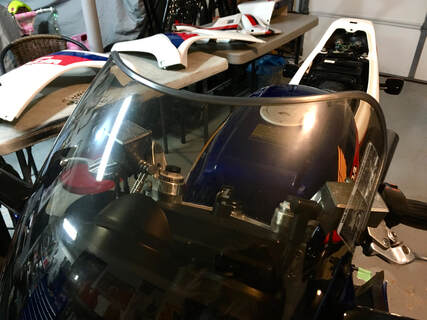
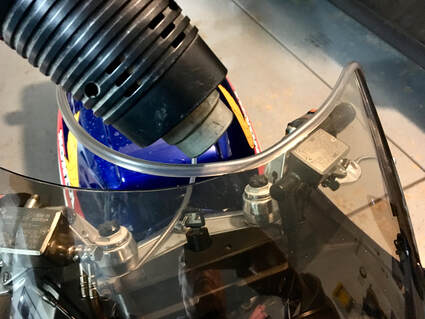
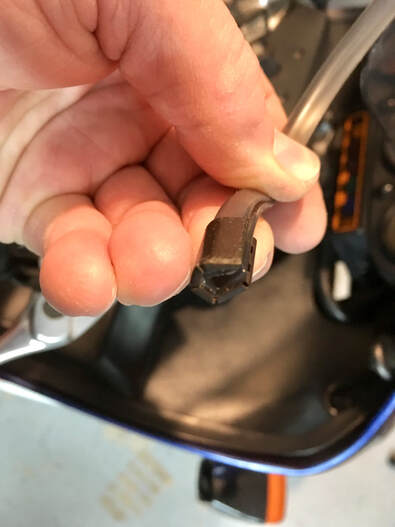
Finally, I gently heat the entire length of the molding making sure it's evenly seated.
Job done.
|
 One of the final bits to finish on the freshening of Project 9 is to install the windscreen molding. This is a vinyl strip that surrounds the exposed edge of the windscreen. It's a factory part, but is no longer available from Honda. Fortunately, I have a few in the warehouse, so let's get it on the bike.  The molding is designed to install by simply pressing onto the windscreen edge, held by friction. In the past, I've had to add a bit of clear adhesive to older molding which had lost its elasticity, but this NOS molding installed easily, with a little help from warming with the heat gun. (Below) Be careful with the heat; the molding has a low melting temperature, which I quickly discovered. Fortunately, extra material is supplied. When I reached the end I snipped off the excess.  One thing to note about the little molding clips, which secure the molding at either end, is that they have an open end and a closed end, so they must install as shown. Slip the clip onto the end of the molding, then with a firm push it pops onto the windscreen, holding the end securely. If yours are missing, these clips are still available from Honda. Finally, I gently heat the entire length of the molding making sure it's evenly seated. Job done.
0 Comments
This past December 16th the shippers arrived at the expansive V4 Dreams campus to load Project 11 onto a cargo truck, the beginning of its long journey to Haugesund, Norway. The bike's new owner, Nils, took a huge leap of faith with me to purchase the 1986 VFR700F and ship it across the Atlantic. Nils, an admittedly impatient sort, busied himself during the two-month shipping wait acquiring OEM mufflers and centerstand, refinishing them in preparation to pass the strict licensing rules of Norway which require a stock configuration. One of the mufflers came from me and one was sourced in Germany. Eventually the day came, the crate unloaded and the Interceptor unveiled to Nils and 4-year old Jacob for the first time. Nils immediately set to work wrestling the mufflers into place and mounting the centerstand. He now has possibly the only U.S.-spec "tariff-buster" 700cc Interceptor in Europe. It's in original condition, shows 23,475 miles and is a beautiful example. And Jacob is a huge fan. Wouldn't it be great if one day it became his.
Facebook's Marketplace has become popular for selling anything and everything, with little consideration for class, decorum, language or photography skills. While casually browsing the other day I came across these three frightening Interceptors offered for sale, plus one that defies sound judgement. (Below) First up is this questionable 1992 VFR750 with an ominous 111,111 miles, purchased by the seller as a parts bike, and conveniently pre-stripped of pretty much anything of value, save for the 8-spoke rear wheel. Described as needing a headlight and "could certainly stand a little cosmetic makeover," the seller is offering it for $1250 firm, but "this weekend only" it can be yours for only $950. Presumably it will go back up to $1250 on Monday if unsold. (Below) Next up is a 1995 VFR750 showing only 25,000 miles but looking a bit worse for wear. Turns out it's been sitting for some ten years and, not surprisingly, "is not currently running." But, rest assured, it was running when parked and had, at the time, been treated to new tires, brakes and fluids. Some of the body plastics have gone missing "from sitting around." No doubt a result of those pesky parts-stealing gnomes who sneak into your garage at night and make off with your bike parts. Our seller adds, endearingly, that he's "tired of looking at the damned thing," and then confusingly offers it for $1000 OBO, then states he's firm on the price (?) yet has changed the listing price to $825. Good luck to seller and buyer. (Below) Last, but not at all least, we have this beast, a 1985 VF700, looking fresh from the swamp. Our seller has gotten "bored with it" (makes me wonder where the original interest came from) and has "never gotten around to getting a title for it." No wonder, as a VIN tag has obviously been pop riveted onto the frame. The price has been lowered to $600 and we're invited to bring our own battery to hear it run. I'll be right over.... (Below) And here we have yet another victim in the VFR trike pandemic. This hapless 1986 VFR700 has been forced into service in a homebuilt Slingshot-style trike affair. The seller aptly notes that it is a very fast "drifter." I'll just bet it is. I'm no safety nazi, but I sure would feel better seeing some seat belts mounted.
The Gulf baby blue and orange racing paint scheme was a common sight fifty years ago, made famous on the Le Mans-winning Porsche 917 cars in 1970 and '71. Its place in history was assured through the Steve McQueen movie Le Mans (1971), the car used in the film selling at a 2017 auction for $14 million. Suffice it to say that the Gulf livery colors have been cemented into racing lore and our collective memories.
I don't know who to credit with this fourth-gen rebuild, but they were fully committed to the look and pulled it off nicely. Without a racing pedigree, the fourth-gen might seem an unusual choice for racing colors, but that's the nice thing about our bikes; we can realize our own vision. Fortunately, during these isolated times, I have lots of shop projects to keep me busy. Project 9, a 1986 VFR750F, has undergone a maintenance regimen, including carburetor cleaning/syncing, stator hardwired, fresh tires mounted, brake checks, fluid flushes, and lots of little chores completed. (Below) I found mice evidence in the airbox which, fortunately, had not damaged the carbs below. This is a stock tuned engine with an OEM air filter installed when I did the original refurbishment eight years ago. The OEM filter is NLA from Honda, but HiFlofiltro now offers an identical-looking replacement which I sourced from Amazon for $20. (part #HFA1707) (click on images to enlarge) (Below) I was interested in disassembling this particular set of carburetors to see how my VITON bowl gaskets and NAPA rubber vacuum caps (for deleting the CA emissions) had withstood eight years of use. The bowl gaskets looked like new, but the same can't be said for the vacuum caps, which had begun to crack and possibly leak. These caps are designed for engine use, so I was surprised to discover this. After some research, I've sourced some 3/16" silicone caps designed for hi-temp applications, so should last a long time. The baby blue color is just a bonus. (Below) The carburetors were still clean and the jets clear, so I just upgraded the fuel tube o-rings and fuel lines, reassembled, then leak-tested. (Below) Next, I found that the headlight was working intermittently, which I traced to the starter switch — this switch is designed to turn off the headlight when depressed. I have found this issue in past projects, and it's simply a matter of the switch contacts becoming contaminated with years of dirt accumulation. The photo points to the switch box, and once removed I simply spray the contacts with electronic cleaner followed by a thin coating of dielectric grease to prevent corrosion. While the assembly is apart, I clean the throttle tube inside and out, and dab some grease on the cable ferules. Job done. (Below) If the right-side switch gear was gummy, I thought I should check the left side. Good thing. The first sign of trouble was the mud dauber nest (arrows). But glancing at the choke cable, I found the cable frayed with only a few strands remaining. It wasn't long for this world. Turns out the cable is NLA from Honda and I couldn't find an aftermarket available in the U.S. Fortunately, I found one in the massive V4 Dreams secret underground parts stash facility so I was able to clean, lube and reassemble. 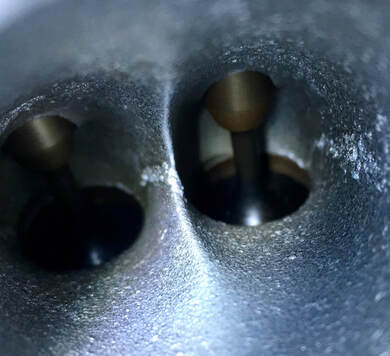 (Right) With the carbs off, I always have a peek at the intake tracts, looking for carbon buildup on the valves and valve stems. These are the cleanest I've ever seen on an older VFR, in fact, they look nearly new. Once the wheels/tires are remounted, this one will be ready for the bodywork to be installed and its test ride.
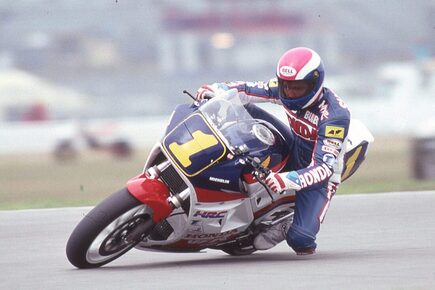 A recent WebBikeWorld.com article by Simon Bertram caught my attention by virtue of its title: The Best Honda Motorcycles Ever Made. That's an ambitious subject, considering we're talking about the world's largest motorsport manufacturer. The lead photo (right) features Bubba Shobert on his championship winning VFR, so one might suspect that the Interceptor won a spot in the list, and it kind of did, by way of the VFR750R, aka RC30. From the author: "...what makes the VFR750R one of the best Honda bikes ever made, is that they were essentially race bikes with street parts on them. If you bought the right HRC parts, which in and of itself was difficult, you could quite literally ride around on a perfectly street legal racing bike. The VFR750R RC30 goes down in history as the winner of the first two World SBK Championship seasons, as well as one of the best homologation specials ever made, and is one of the most sought after Honda bikes of all time for the collector’s market. It’s also one of the greatest Honda motorcycles ever made simply because it was designed, made, and built for one purpose only: to utterly destroy every other manufacturer on the track, which it did in fine style." 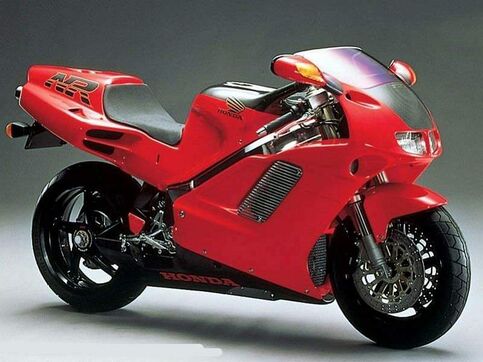 Also listed was the NR750 V4: "This, here, was the bike that launched the hypersport name. This, here, was the motorcycle that dared to push the limits of what was acceptable in a street bike. This, here, was the beast that revolutionized so much about motorcycles that it is cemented in history. This, here, is the 1992 Honda NR750." For more on what makes the NR historically significant, check out this VisorDown article.
 Three years ago we lost an old riding friend, Steve "Butch" Boyle. Over the past several years Butch had put together a small collection of bikes that were important to him, including this 1986 VFR750F, which he acquired from me in 2012 as Project 9. Since his passing, the bike has sat idle and is now showing the effects; won't start plus some deferred maintenance due. The decision has been made to keep the Interceptor in the family, so yesterday I retrieved the bike and will take care of the necessary tasks while upgrading a few items. This bike originally came to me in 2012 with unpainted aftermarket body panels installed, specifically the large side fairings, headlight fairing and rear cowl. The rear cowl is unique in that it was made as a single piece all the way forward to the fuel tank. These parts were made by Chuck Crites (Colbalt Racing) and are laid-up fiberglass items; a bit heavier than OEM but very robust. During the build I had those panels and the headlight fairing repainted. The engine is tuned to stock and the mufflers are factory originals. The bike shows 24,700 miles and is quite the stunner. I'm very pleased that the bike will be staying with my old friend's family and honored to be entrusted with its care. 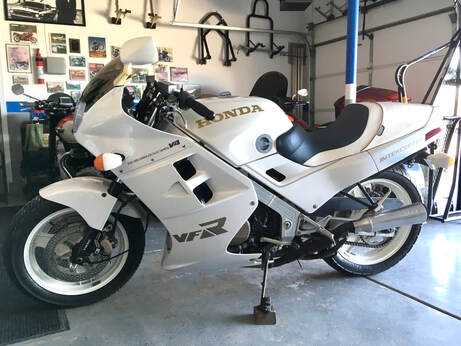 Two weeks ago Patti and I trailered about six hours south, to southern Illinois, to retrieve my latest project, this Pearl Crescent White 1986 VFR700F2. The seller, Mike, was no longer making full use of the bike and it was beginning to show in the form of a dead battery and locked brake caliper. He decided the best tack was to find his baby a good home. The Interceptor came to me with a period Corbin color-matched seat and a set of SuperTrapp mufflers installed along with the originals in excellent condition, but otherwise looking quite original.  Within a few days of arriving in the shop, I had the bike stripped and began an assessment. In this case, the bike arrived in running condition, so I'm confident we have a good base. The usual systems refurbishment will need to be attended to, and the tires are from 1994, but the carbs are looking good and the steering head bearings check out OK. The fuel tank and a couple of panels have been repainted sometime in the past, and I would give the cosmetics an 8.5 overall. The odometer is showing 31,000 miles. Still thinking about which direction to take with the build. (Below) On the drive home, we happened to gas up next to this trailer ladened with new Honda Goodness. Most of the boxes were hiding CBR1000RR-R's inside (that's a lot of R's), along with a few lesser models. I offered the driver a trade, but no go. Welcome to the shop, Project 27. 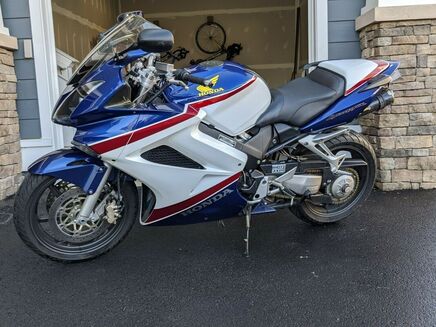 Click on image for the eBay listing. Click on image for the eBay listing. What: 2007 VFR800A Anniversary Where: Arlington, Virginia Why: Low miles, ABS Price: Auction The red/white/blue 25th Anniversary Edition was an unloved special edition in 2007, but has come into its own in later years. This particular example stands above the crowd by virtue of the relatively rare ABS option, along with some very useful, and expensive, upgrades; TBR slip-on mufflers, LSI bar risers and a Power Commander. Showing only 13,000 miles and in beautiful, original condition, this looks to be a perfect candidate for someone looking for a top of the line 6th-gen...well, a set of white wheels might be nice. |
THE SHOP BLOG
|